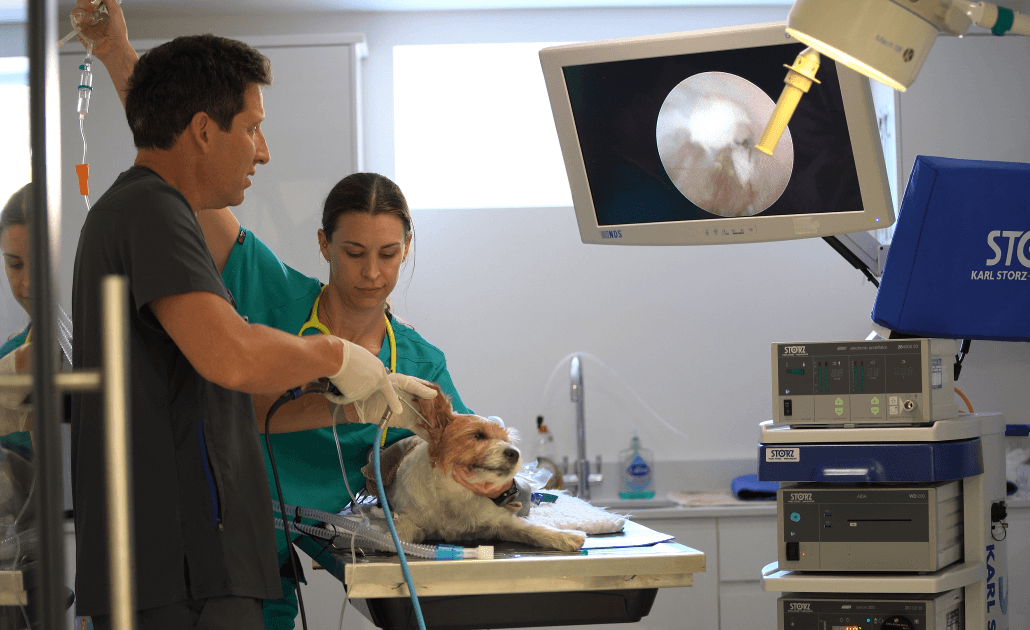
Many veterinary professionals aspire to own their own practice - and it’s easy to see why.
Not only do you get total creative control over how the business is run, but you also have the opportunity to massively ramp up your earning potential in both the short-term and further down the track if you decide to sell up.
But let’s not get ahead of ourselves. First, you’ll need to secure the capital needed to start your practice. And, let’s be honest - starting a practice ain’t cheap.
The good news is that there are a bunch of different funding options at your disposal. In this comprehensive guide, we'll walk you through the various sources of finance for starting a veterinary practice to help you make a more informed decision about which type of funding is right for you.
Note: The information provided here is for general informational purposes only and should not be construed as financial, investment, or professional advice. Always consult with a qualified financial advisor or professional before making any financial or investment decisions.
Key takeaways
Starting your own veterinary practice is an ambitious and rewarding endeavor, but securing the necessary finances is a critical first step.
There are many funding options for aspiring practice owners, including self-funding, SBA loans, bank loans, partnerships, equipment financing, and business lines of credit.
It’s important to understand the advantages and considerations of each option in order to make an informed decision.
1. Self-funding

Relatively high upfront costs can make it tricky to bootstrap (the process of starting up a company with no outside financing) a veterinary practice. Still, depending on your goals and your financial circumstances, you may be in a position to tap into your personal savings and/or cash out some investments to self-fund the business and bring your practice to life.
There are some significant risks with this approach, so you’ll need to consider the pros and cons carefully before making any decisions.
Advantages of self-funding a veterinary practice
No debt obligations: You’re doing it with your own money. There are no regular loan payments to worry about, which frees up cash flow for other business needs or personal expenses.
No interest costs: No loan means no interest. This can save you substantial amounts of money in the long run.
Greater control: You have complete control over the business without any external lenders or partners.
Lower financial risk: You won't face the risk of defaulting on a loan and damaging your credit score if the business encounters challenges.
Considerations for self-funding a veterinary practice
Limited capital: Starting a mobile practice costs at least $200,000, while building a traditional small animal practice can easily exceed $1 million. Many aspiring practice owners do not have that level of capital to invest in a new business. Limited capital can restrict the scope and scale of your practice.
Reduced personal savings: Using your own money can deplete your personal savings, potentially leaving you with fewer financial resources for emergencies or personal needs.
Opportunity costs: By tying up your own money in the practice, you may miss out on other investment opportunities that could potentially provide better returns.
Stress: Self-financing can put strain on your family and personal life. When business is slow or you run into unexpected expenses, you may struggle to cover your living costs.
Tips for managing personal finances
Self-financing a business can have a significant impact on your personal finances. Comprehensive analysis and financial planning will be required before making any decisions, but keep the following tips in mind as a starting point.
Create a detailed budget: Develop a comprehensive budget that covers all anticipated expenses, including equipment, staffing, and operational costs. This will help you allocate your personal funds wisely.
Set realistic goals: Establish realistic financial goals for your practice, taking into account both short-term and long-term objectives.
Emergency fund: Maintain a separate emergency fund to cover unexpected expenses or financial setbacks, ensuring your personal finances remain stable.
Separate personal and business finances: Keep your personal and business finances separate to maintain transparency and simplify accounting.
Avoid withdrawing from retirement accounts: While you may technically be able to tap into retirement accounts, doing so may mean losing out on significant returns in the future, along with incurring possible tax penalties.
2. SBA 7(a) loan

An SBA 7(a) loan is a type of loan program offered by the US Small Business Administration (SBA) to provide financial assistance to small businesses. It’s one of the most popular and versatile loan programs provided by the SBA and is designed to help small businesses with various financing needs, including working capital, business expansion, equipment and inventory, debt refinancing, and startup capital.
These loans are not provided directly by the SBA but are offered through a network of approved lenders, such as banks and credit unions. The SBA guarantees a portion of the loan, which reduces the lender's risk, making it easier for small businesses to qualify for financing and access capital at more favorable terms, including lower interest rates and longer repayment periods.
Advantages of starting a vet practice with an SBA 7(a) loan
Flexible terms: SBA 7(a) loans typically offer longer repayment terms (seven years for working capital, 25 years for real estate) compared to conventional loans, which can help manage cash flow during the initial stages of the business when revenue may be lower.
Lower down payments: SBA loans often require smaller down payments compared to traditional commercial loans, making them more accessible for veterinarians who may not have substantial upfront capital.
Competitive interest rates: There's a predefined cap on maximum interest rates for SBA loans. A lower interest rate means smaller monthly payments and overall financing costs.
Considerations for starting a vet practice with an SBA 7(a) loan
Strict qualification criteria: SBA loans have specific eligibility criteria. Meeting these requirements can be challenging for some applicants, and the application process can be time-consuming.
Paperwork and documentation: The application process for SBA loans typically involves a significant amount of paperwork and documentation, including a detailed business plan, financial statements, and tax returns.
Loan approval time: SBA loan approvals can take longer compared to some other forms of financing. If you need capital quickly to start your practice, the time it takes to secure an SBA loan may be a disadvantage.
Want to learn more about SBA loans? You can use SBA’s handy Lender Match tool to connect with a participating SBA lender.
3. Bank loan

Some banks offer specialized loans specifically geared towards people aspiring to build or purchase their own veterinary practices. Rates and terms vary between lenders and tend to be higher than SBA loans (though still competitive). The better your financial position, the easier it is to negotiate.
The good news is that banks tend to look favorably at veterinary borrowers, thanks to the stability and revenue generating potential associated with businesses operating within the animal healthcare industry.
Advantages of starting a vet practice with a veterinary practice loan
Tailored to your needs: These loans are specifically designed for veterinary professionals, which means they are customized to meet the unique financial requirements of a veterinary practice.
Flexible terms: Lenders often offer flexible repayment terms, making it easier to manage your finances during the early stages of your practice.
Competitive interest rates: With specialized loans, you may be eligible for competitive interest rates, reducing the overall cost of financing your practice.
Support and expertise: Many lenders in this niche offer valuable support and expertise, which can be beneficial as you navigate the complexities of starting and managing a veterinary practice.
Considerations for starting a vet practice with a veterinary practice loan
Interest rates: Be sure to understand the interest rates associated with the loan and how they will impact your monthly payments and overall loan cost.
Repayment terms: Evaluate the repayment terms and determine if they align with your expected cash flow and revenue projections.
Loan amount: Only borrow what you need to launch and sustain your practice. Avoid overborrowing to prevent unnecessary debt.
Creditworthiness: Your personal and business credit history will play a significant role in your loan eligibility and interest rates.
Lender reputation: Research lenders carefully, read reviews, and consider recommendations from industry peers to ensure you choose a reputable institution.
How to obtain a veterinary practice loan
Research lenders: Begin by researching financial institutions that specialize in veterinary practice financing. Look for reputable lenders with experience in the industry.
Determine your loan amount: Calculate the amount you need to start your practice, factoring in expenses such as equipment, leasehold improvements, working capital, and initial inventory.
Compile necessary documents: Lenders typically require documents like a business plan, financial projections, personal financial statements, and a detailed plan for how you'll use the loan.
Submit the application: Fill out the loan application and submit it along with the required documents to your chosen lender.
Review and approval: The lender will review your application and documents. If your application is approved, the lender will provide the terms of the loan, including interest rates and repayment terms.
Closing and disbursement: After agreeing to the terms, you'll close the loan, and the funds will be disbursed to you for use in starting and operating your veterinary practice.
Remember, your credit history plays an important part in the approval process; expect to run into some challenges if you’re still establishing business credit and/or don’t have an existing relationship with the lender.
4. Veterinary practice partnerships

A veterinary practice partnership refers to a collaborative business arrangement where two or more veterinarians come together to jointly own and operate a veterinary practice. This type of partnership can take various forms, and the specific structure and terms can vary based on the needs and preferences of the partners.
Entering into a partnership with an established veterinary practice can be a strategic move to secure funding and benefit from experienced guidance. However, successful partnerships require clear communication, mutual trust, and a shared commitment to the practice's mission and goals.
Advantages of starting a vet practice through a partnership
Access to capital: Partnerships often involve pooling financial resources from multiple individuals, which can provide a significant amount of capital to start or purchase a veterinary practice.
Shared financial responsibility: In a partnership, the financial burden is shared among the partners. This can reduce the pressure on each individual partner and make it more manageable to cover the practice's expenses and debt obligations.
Complementary skills: Partnerships can bring together individuals with different skills and expertise. For example, one partner may excel in clinical veterinary care, while another may have strong business management or marketing skills. Combining these talents can enhance the practice's overall capabilities.
Easier financing: Lenders may be more willing to provide financing when multiple partners are involved, as it can increase the perceived stability and capacity to repay loans.
Considerations for starting a vet practice through a partnership
Alignment of goals: Ensure that all partners share similar long-term goals and visions for the practice. Misaligned objectives can lead to conflicts and hinder the practice's growth.
Financial and legal obligations: Partnerships require careful legal documentation, including a partnership agreement that outlines each partner's rights, responsibilities, and financial contributions.
Compensation structure: Establish a clear compensation structure for the partners, including salaries, bonuses, and distribution of profits. It should be based on roles, responsibilities, and contributions to the practice.
Legal liability: Partnerships often entail shared legal liability. Be aware that you may be personally responsible for the actions of your partners and the practice as a whole.
Exit strategy: Consider how partners can exit the partnership if circumstances change. Having a buy-sell agreement in place can outline the terms under which a partner can sell their stake in the practice or how the practice will handle a partner's departure or retirement.
It's essential to consult with legal and financial advisors to structure the partnership agreement and address important legal and financial aspects of the arrangement.
Finding and negotiating with potential partners:
Finding the right partner is crucial. Here's how to identify and approach potential veterinary practice partners:
Network within the industry: Attend industry conferences, workshops, and events to connect with potential partners. Join veterinary associations and online groups to expand your network.
Research local practices: Identify established veterinary practices in your area that align with your goals and values. Consider factors like specialization, client demographics, and location.
Reach out: Contact potential partners to express your interest in forming a partnership. Be prepared to discuss your vision, goals, and how the partnership can benefit both parties.
Evaluate compatibility: Assess the compatibility of your practice philosophies, management styles, and long-term objectives. A successful partnership requires shared values and goals.
Seek legal counsel: Once you've identified a potential partner, seek legal counsel to draft a partnership agreement that outlines roles, responsibilities, ownership, and financial arrangements.
Financial arrangements: Discuss how financial contributions and profits will be shared. Consider factors like initial investment, ongoing expenses, and revenue distribution.
Due diligence: Conduct due diligence on the partner's practice, including a financial audit, to ensure transparency and minimize risks.
Partnerships are long-term commitments, so take the time to find the right fit. A well-structured partnership can provide the financial support and expertise needed to thrive in the veterinary industry.
5. Equipment financing

Equipment financing is a form of business financing that helps businesses acquire the physical assets they need to operate and grow. It allows businesses - including aspiring veterinary practice owners like yourself! - to purchase or lease the necessary equipment without having to pay the full upfront cost. Instead, you make regular payments over a predetermined period, which can range from a few months to several years. Some diagnostics suppliers, like IDEXX, may provide free equipment to new practices, which helps further reduce the barrier to entry.
There are typically two main types of equipment financing options:
Equipment lease: In a lease agreement, you rent the equipment for a specific period and return it at the end of the lease term. This can be a good option if you anticipate needing upgraded equipment in the future.
Equipment loan: With a loan, you borrow the funds to purchase the equipment. You then make regular payments, including interest, until the loan is paid off. Once it's paid off, you own the equipment outright.
Rates and terms depend on your qualifications, the type of equipment you’re purchasing, and current market conditions. Securing equipment financing is often easier than other types of loans because the equipment serves as collateral.
Advantages of equipment financing
Preservation of capital: Instead of paying for equipment upfront, you can make regular payments over time, preserving your cash flow for other essential expenses, such as operational costs, marketing, and unexpected emergencies.
Consistent budgeting: Equipment financing typically involves fixed monthly payments, making it easier to budget for and manage your finances. This predictability helps you avoid unexpected fluctuations in expenses.
Tax benefits: Depending on your location and tax laws, you may be eligible for tax benefits when you finance equipment. These benefits can include depreciation deductions, tax credits, or other incentives, which can reduce your overall tax liability.
Asset ownership: If you opt for an equipment loan instead of a lease, you'll eventually own the equipment outright once the financing term is completed. This can add valuable assets to your balance sheet and potentially increase your business's overall value.
Considerations for equipment financing
Leasing vs purchasing: Consider whether it's more advantageous to lease or purchase equipment. Leasing can reduce upfront costs and provide flexibility, while purchasing offers long-term ownership benefits.
Identify essential equipment: Prioritize the equipment that is critical for your practice's core services. Create a list of must-have items and optional equipment.
Forward planning: You need to have a clear idea of what you’re buying before applying for equipment finance. In most cases, the equipment financier pays the equipment vendor without money ever entering your bank account.
Total cost of ownership: Over time, the total cost of financing equipment may be higher than if you had purchased the equipment outright. This is especially true if you choose a longer financing term or opt for a lease with no option to purchase the equipment.
Collateral requirements: Some equipment financing agreements may require you to provide collateral, which could be a lien on the equipment or other business assets. This means that if you default on the loan, you could lose the equipment or other assets used as collateral.
Acquiring the necessary equipment is a critical step in setting up your veterinary practice for success. By carefully weighing your financing options and choosing the right equipment, you can provide the highest level of care to your patients and position your practice for growth.
Check out this webinar for more information on the best tools and integrations for new veterinary practices!
6. Business lines of credit

A business line of credit is a flexible financing option that provides access to a predetermined credit limit. It can serve as a financial safety net, ensuring you have access to funds when needed.
Business lines of credit can be secured or unsecured:
Secured line of credit: Requires collateral, such as business assets or personal assets, to secure the line of credit. Secured lines of credit typically offer higher credit limits and lower interest rates.
Unsecured line of credit: Does not require collateral but may have stricter eligibility criteria. Unsecured lines of credit often have lower credit limits and slightly higher interest rates.
Strong repayment discipline is critical when it comes to business loans of credit. Interest rates and late fees on lines of credit can be steep and may compound rapidly, which means it’s essential that they’re used judiciously and only on an as-needed basis.
Advantages of using a business line of credit to start a vet practice
Flexibility: A business line of credit provides flexibility in terms of when and how you use the funds. You can draw from the line of credit as needed and only pay interest on the amount you use.
Working capital: It can help you manage day-to-day working capital needs, such as covering payroll, purchasing inventory, and managing cash flow during seasonal fluctuations.
Emergency funds: A line of credit can serve as a financial safety net for unexpected expenses, emergencies, or opportunities for growth.
Builds credit history: Responsible use of a business line of credit can help build and improve your business's credit history, which can be beneficial for future financing needs.
Considerations for using a business line of credit to start a vet practice
Potential for overuse: The ease of access to funds can lead to overuse if not managed carefully, potentially leading to financial stress. Create a budget that outlines how you'll use the line of credit funds. Avoid unnecessary or frivolous expenses.
Interest rates: Be aware of the interest costs associated with the line of credit. Pay down the balance as quickly as possible to minimize interest expenses.
Credit limit: The credit limit on a line of credit may not be sufficient for larger financing needs, such as major expansions or significant capital investments.
Lender requirements: Lenders may impose requirements or restrictions on how the line of credit can be used, and they may require periodic reviews of your financials.
Collateral or personal guarantee: Depending on the lender and the creditworthiness of your business, you may need to provide collateral or a personal guarantee to secure the line of credit.
Conclusion
In conclusion, starting your own veterinary practice is an ambitious and rewarding endeavor, but securing the necessary finances is a critical first step. By considering the various sources of finance discussed in this guide, you can embark on your journey with confidence.
Financial planning and strategic decision-making are key components of practice ownership. Remember that each funding source has its own advantages and considerations, so carefully assess your practice's needs and align them with the most suitable financing options. With dedication, careful planning, and the right financial support, you can build a thriving veterinary practice that makes a positive impact on the lives of animals and pet owners in your community
Ready to take the next step? Download our comprehensive new practice guide to learn more about starting your very own veterinary clinic!